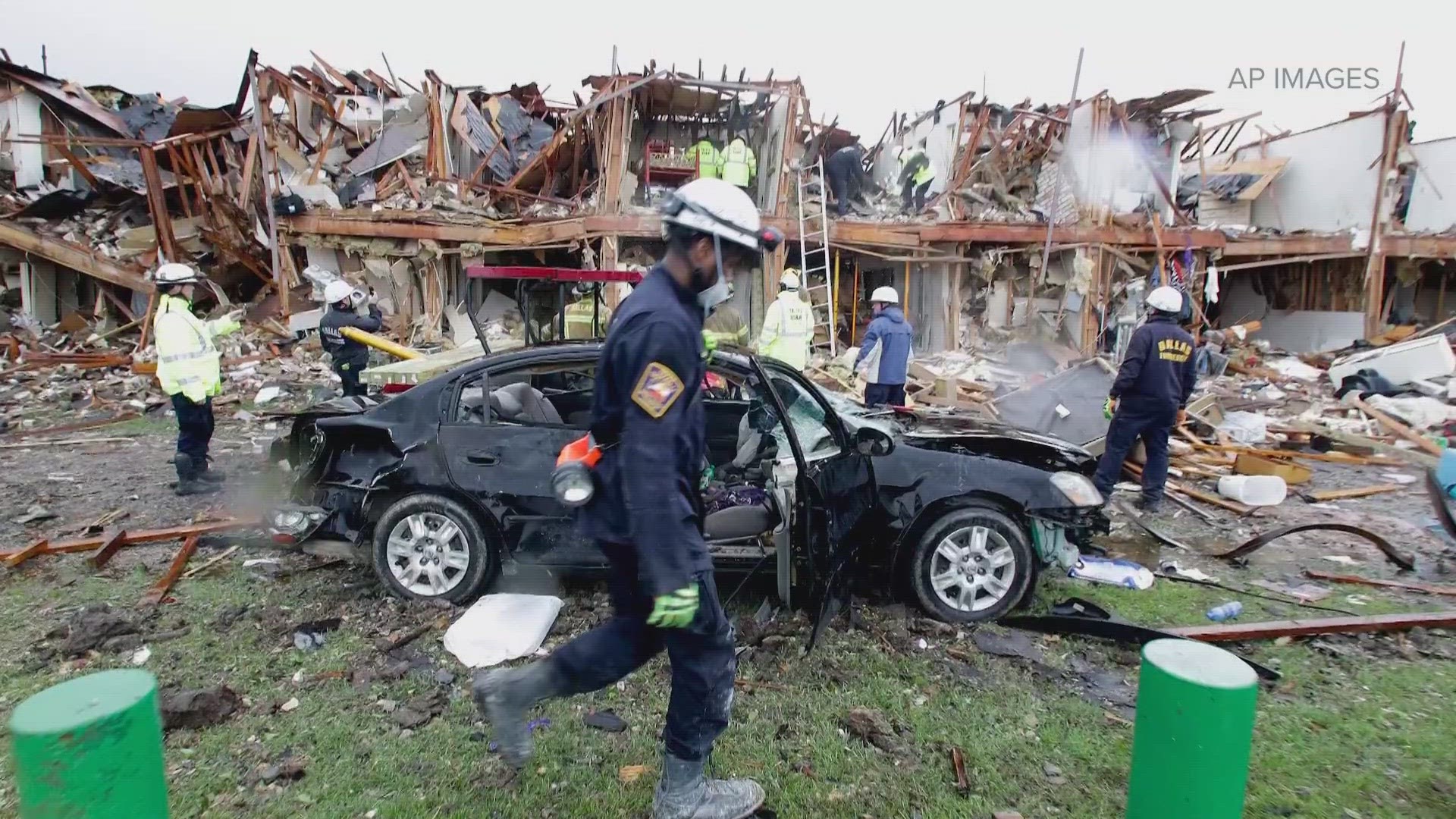DALLAS, Texas — On Saturday, the town of West, Texas, memorialized and honored fifteen lives claimed during an explosion that changed the course of its small community forever.
The tenth anniversary of the West explosion is Monday night. On April 17, 2013, approximately 30 tons of ammonium nitrate exploded at the West Fertilizer Co. (WFC) plant following a fire.
Approximately 260 were injured, and more than 150 buildings were heavily damaged or destroyed.
The total insurance-related losses from the explosion are estimated at around $230 million.
The fire and subsequent explosion were part of a perfect storm.
The cause of the fire is a mystery to the Bureau of Alcohol, Tobacco, Firearms, and Explosives (ATF). By process of elimination, the ATF believes the fire was intentionally set, though that determination is disputed by many.
The culprit of the explosion is much clearer. When the explosion happened, WFC had approximately 40 to 60 tons of ammonium nitrate at its facility.
The building housing it all was wooden. It was built in the 1960s with a wood frame, the rafters were wooden, and even part of the roof was plywood.
The ammonium nitrate was even stored in a wooden bin.
The U.S. Chemical Safety and Hazard Investigation Board found "the construction of the bins and other building materials, as well as the lack of an automatic sprinkler system, plausibly contributed to the detonation."
The poor storage practices and lessons learned from that tragic evening haven't evolved into better oversight and regulations regarding the chemical compound used to make fertilizer, per Dr. Vyto Babrauskas.
Babrauskas is an independent science consultant for fires and explosions. He founded Fire Science and Technology Inc. in 1993 to devote himself to fire safety research and development.
He's closely studied the West explosion and has published ten papers about preventing a similar catastrophe from happening again.
Per Babrauskas, there is a better understanding of what ammonium nitrate can do due to the West explosion, but he implied that things aren't necessarily safer.
"This is a problem that's very widespread beyond the state of Texas," Babrauskas said. "The best solution here is to get these products out of combustible buildings."
Per Babrauskas, there are over 1,300 facilities nationwide that store significant quantities of ammonium nitrate. Many, he said, are old, wooden and combustible.
In 2016, the U.S. Chemical Safety and Hazard Investigation Board said that 19 other Texas facilities storing more than 10,000 pounds of ammonium nitrate were "located within 0.5 miles of a school, hospital, or nursing home, raising concerns that an incident with offsite consequences of this magnitude could happen again."
"It is crucial to point out that almost nothing of substance was done in the intervening decade to make such tragic loss of life less likely," Babrauskas said.
The National Fire Protection Association revised its Hazardous Material Code, NFPA 400 regarding ammonium nitrate. But it only applies where there is a building code and an authority with jurisdiction over it, according to Babrauskas.
In the revised code, only new ammonium nitrate storage facilities would be built with noncombustible construction materials, must include fire sprinklers and a one-mile evacuation zone would be established around such facilities.
But Babrauskas called these changes "window dressing."
"The updated provisions still do not forbid existing wood building and wood storage bins. If the building in West were still standing, the updated NFPA 400 would not have required that it be replaced by a noncombustible one," Babrauskas said.
Babrauskas said the only true regulating agency with policing power that could levy fines or penalties efficiently is the Occupational Safety and Health Administration, or OSHA.
It's the primary agency regulating safety in workplaces, but according to Babrauskas, it has done little regarding ammonium nitrate storage since West.
To this day, storage of ammonium nitrate in wooden bins or facilities is not prohibited by OSHA but is also not encouraged.
Automatic sprinklers are also not required for facilities unless there are more than 2,500 tons of bagged ammonium nitrate in one place.
Again, the West explosion involved less than 60.
"The best solution would be to have OSHA put in place and enforce useful regulations," Babrauskas said. "If only they could muster up the courage and the willingness to take this step. There's no other agency on the federal level that is in a position to make this kind of enforcement."
Babrauskas said that lobbyists in the agriculture sector have largely stood in the way of any good policy or regulation headway.
"They need to do the right thing for this particular hazard because we don't want to be losing more firefighters," Babrauskas said. "It shouldn't be a big burden to the owners of these facilities to migrate the product into more non-combustible structures."
Texas did pass legislation in 2015 that gave fire marshals better access and power to inspect ammonium nitrate storage facilities to make sure they're safe.
However, a spokesperson for the State Fire Marshal's Office told WFAA that in the last ten years, the agency hasn't handed down any penalties or fines to facilities for poor ammonium nitrate storage practices.
The spokesperson said that facilities have complied with requests to make things adequately safer if there have been violations.

